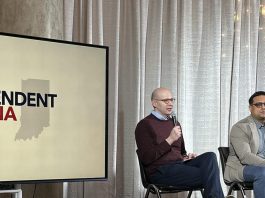The Indiana House of Representatives voted 95-0 to advance State Rep. Holli Sullivan’s (R-Evansville) legislation that would pave the way for local governments to begin partnering with companies to utilize autonomous delivery robots in communities throughout the state.
According to FedEx, on average, more than 60 percent of small businesses’ consumers live within three miles of a store location and expect more products to be delivered to their home. To support the use of this growing technology, Sullivan’s bill would set up guidelines for device regulations, acceptable roadway routes and local government involvement.
“The pandemic highlighted the importance of businesses thinking outside the box to get their products to Hoosiers’ doorsteps,” Sullivan said. “This bill sets up a framework to help local cities and towns partner with businesses, like FedEx and Amazon, to decide if this new delivery technology is the right fit and how best to deploy it.”
Sullivan said a personal delivery device is a robot that delivers goods to consumers through contactless methods. She said each device has different specifications depending on its service provider and types of goods it’s meant to carry. FedEx’s robot, named Roxo, stands approximately four feet tall, is able to carry up to 100 pounds, travels within a five-mile radius and can climb steps and curbs to deliver packages. In comparison, Amazon’s electronic robot, called the Amazon Scout, is smaller and drives best along sidewalks in neighborhoods. Hoosiers could order takeout, groceries or receive small or large packages. Sullivan said even before COVID-19, there was a growing need for on-demand, hyper-local delivery services, but now the pandemic has highlighted the importance of alternative ways for Hoosiers to receive online purchases.
According to Sullivan, House Bill 1072 would also include safeguards, allowing neighborhoods to voice their support or concern if a program were to start in their community and establishing requirements for devices to have such as cameras, headlights, turn signals, accessibility and more.
By implementing these devices, Sullivan said she also expects it to generate more jobs as people would be needed to maintain or repair each device, analyze data and monitor the devices’ operation.
“Indiana invests a large amount of money in K-12 STEM education, and we are nationally known for some amazing higher education institutions,” Sullivan said. “Having this kind of innovation would create job opportunities for those students, and encourage them to continue living and working in Indiana.”



